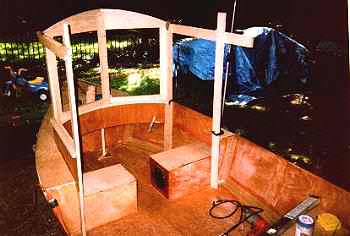Building the Tubby Tug
Page 2I traced out the full-size patterns using carbon paper and did as much pre-encapsulating as practical. Never having applied resin to a large flat surface before, I experimented a bit with different methods before accepting the fact that foam rollers, which aren't cheap, yield the easiest and best finish. Stitching and filleting was very straightforward, and I ended up leaving most of the copper wire in the hull after snipping the ends off. I used wood flour to make the fillets in the interior of the hull and a mixture of silica and microspheres elsewhere.

Once the hull was stitched together, I found that I needed to move the project from my parents' house at the New Jersey shore to my house in Philadelphia in order to have more time to work on the fitting of the cabin to the hull. One of the big advantages of stitch and glue construction is that since you usually don't need a building jig, moving the hull can easily be done at almost any time. I completed the hull and cabin assembly (prior to fiberglassing) under a tarp fastened to the edge of my deck, which happens to be far enough off the ground. This let me work on the cabin in my basement shop at the same time.
For peace of mind regarding safety, I opted to pour two-part floatation foam in every compartment and didn't attempt to make them waterproof, although I was careful to encapsulate the interiors.
I opted to fashion the cabin out of red oak, mainly because I could just go down to the home center and buy what I needed. Red oak is very poorly thought of by boatbuilders because it tends to absorb and hold moisture, and therefore rots easily. However, in this case I'm sure it's OK because it isn't used for any major hull components. Besides, I don't expect the boat to be stored outside or kept in the water, so rot really shouldn't be an issue at all. Red oak is an attractive wood (in my opinion) and I think it makes the cabin look especially nice. The cabin sides were made of leftover okoume from the hull. The plans suggest using a router with a veining bit to make the sides look like they are planked. I took the suggestion and I think it adds a nice touch.

The construction of the cabin is quite a bit more involved than building the hull, and requires some woodworking skills. One has to rip boards to accurate bevels and cut away excess wood after assembly using a chisel and plane. While you can build most of the hull with only a jig saw and a drill, the cabin really calls for a tablesaw, bandsaw, and miter box. A determined builder could probably succeed without these, but it would take a lot longer. The cabin also has to be fitted carefully to the hull after the front is built, since no two stitch and glue hulls come out exactly the same. I found all of this a lot of fun, but a truly inexperienced builder might find it a bit daunting. The plans are accurate and clear, however, and the recommended building sequence makes a lot of sense, although there are times when the builder needs to plan ahead carefully to make everything fit together well.